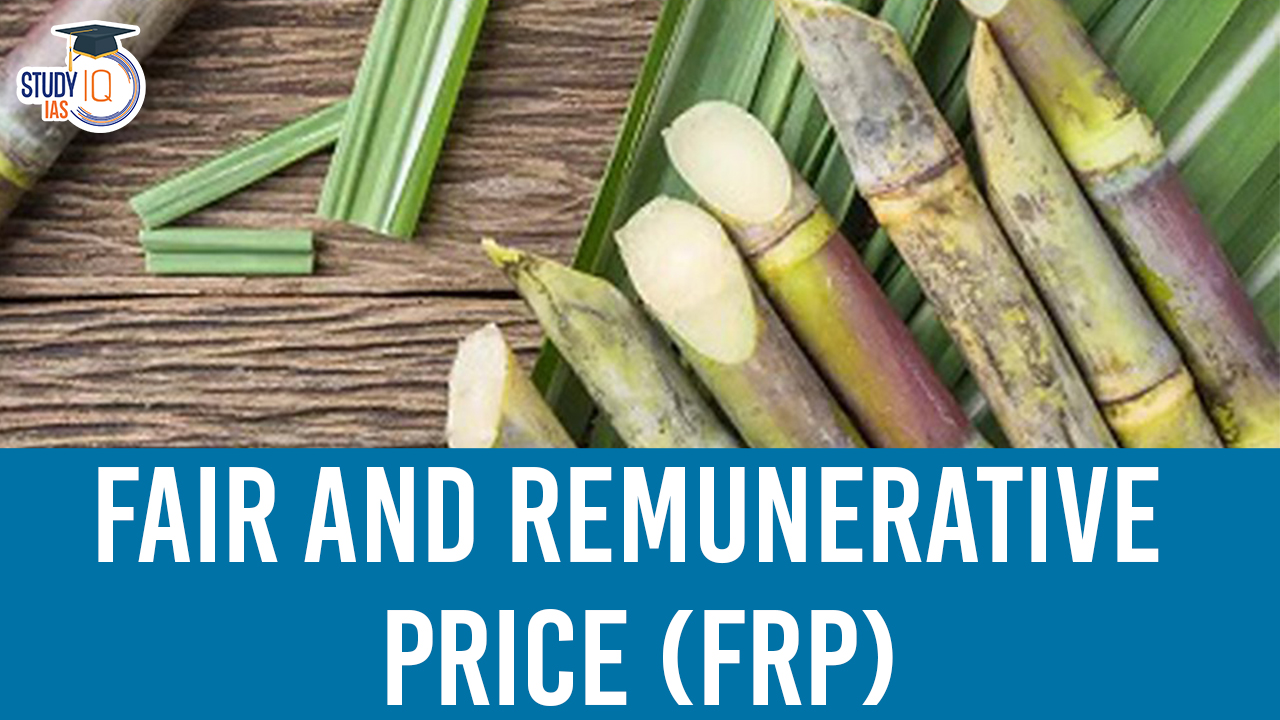Table of Contents
Context: The Union Cabinet has approved the Fair and Remunerative Price of sugarcane payable by Sugar Mills to sugarcane farmers for the sugar season 2025-26.
Fair and Remunerative Price (FRP)
Fair and Remunerative Price (FRP) is the minimum price that sugar mills are legally obligated to pay to sugarcane farmers for the cane they procure.
- Who determines the Fair and Remunerative Price (FRP?
- Union government: Cabinet Committee on Economic Affairs (CCEA) based on recommendations from the Commission for Agricultural Costs and Prices (CACP).
- The payment of FRP is governed by the Sugarcane Control Order, 1966. It mandates that mills pay the FRP within 14 days of cane delivery.
- It ensures farmers receive a fair return, regardless of sugar mill profits & applies uniformly across India.
- Some states offer additional State Advised Prices (SAP) on top of FRP.
Factors considered while fixing FRP
- Cost of sugarcane production.
- Return from alternative crops.
- Consumer sugar prices.
- Sale price of sugar.
- Sugarcane-to-sugar recovery rate.
- Income from by-products (e.g., molasses, bagasse).
- Adequate profit margins for sugarcane growers.
Fair and Remunerative Price (FRP) Overview
| Aspect | Description |
| Definition | The price mandated by the government for sugar mills to pay to farmers for cane procurement. |
| Payment Structure | Two-tranche system:
|
| Dependency | Previously reliant on last season’s FRP. Now tied to the current season’s recovery rates. |
| Factors Considered | Cost of production returns from alternative crops, sugar availability, recovery rates, by-product realisation, risk and profit margins for growers. |
| Payment Timing | Instalments may not align with traditional lump sum payments at season start, impacting financial planning. |
| Farmers’ Concerns | Income instability, loan repayment challenges, and risk factors are introduced by variability in FRP payments. |
| Regulatory Framework | Governed by the Sugarcane Control Order, 1966, under the Essential Commodities Act (ECA), recommendations by CACP, and approval by CCEA. |
| Implications | Crucial for farmers’ livelihoods and sugarcane industry sustainability; impacts income and financial stability. |
| Importance | Supports sugarcane farmers, ensures fair compensation, influences industry dynamics and farmer welfare. |
We’re now on WhatsApp. Click to Join
Government Resolution On Fair and Remunerative Price (FRP)
The new resolution introduced by the Maharashtra Government modifies the payment structure for FRP in two significant ways:
- Two-Tranche Payment: Sugar mills are now permitted to pay FRP in two instalments. The first instalment, based on the average recovery of the district, is due within 14 days of cane delivery. The second instalment, calculated after the closure of the mill, incorporates final recovery data, including sugar and ethanol production from molasses and is to be paid within 15 days thereafter.
- Seasonal Recovery Dependency: Unlike the previous system, which relied on the previous season’s FRP, the new resolution ties payments to the current season’s recovery rates. This means that farmers’ payments will be contingent upon the actual performance of the sugarcane in the ongoing season.

Farmers’ Concerns and Protests
Farmers in Maharashtra have voiced their discontent with the new payment resolution, citing several concerns:
- Income Instability: The dependency on seasonal recovery rates introduces uncertainty into farmers’ income calculations, potentially impacting their financial stability.
- Timing of Payments: Farmers traditionally rely on a lump sum payment at the beginning of the season to cover expenses and investments for the upcoming crop cycle. The instalment-based system may disrupt this financial planning.
- Loan Repayment: Farmers fear that while they are expected to adhere to regular loan repayment schedules and other expenses, the instalment-based FRP may not align with their financial obligations.
- Risk Factor: The variability in FRP payments based on seasonal recovery rates adds a layer of risk for farmers, potentially affecting their profitability and livelihoods.
Implications of FRP Payment Method
The payment of FRP plays a crucial role in the livelihoods of sugarcane farmers and the overall sustainability of the sugarcane industry. By transitioning to a two-tranche payment system tied to seasonal recovery rates, the Maharashtra Government aims to align FRP payments with current industry dynamics. However, the implementation of this resolution raises valid concerns about its impact on farmers’ incomes, financial stability, and overall welfare.
About Sugar Cane Crop
- Growing conditions:
- It is a tropical crop which requires 10 to 18 months to mature.
- Temperature: Between 21-27°C with a hot and humid climate.
- Rainfall: Around 75-100 cm.
- Excessive rainfall can lead to low sugar content, while insufficient rainfall produces fibrous crops.
- Soil Type: Deep, rich loamy soil.
- Top Sugarcane Producing States:(1) Uttar Pradesh (2) Maharashtra (3) Karnataka.
- India has the largest area under sugarcane cultivation in the world.
Also Read: Sugarcane Industry in India
| Sugar Industry |
|
| UPSC PYQ |
| Q. The Fair and Remunerative Price (FRP) of sugarcane is approved by the: (2015)
(a) Cabinet Committee on Economic Affairs. (b) Commission for Agricultural Costs and Prices. (c) Directorate of Marketing and Inspection, Ministry of Agriculture. (d) Agricultural Produce Market Committee Answer: A |


 Rise of Orange Economy in India
Rise of Orange Economy in India
 Concept of GDP, GNP, NNP and NDP, Basic ...
Concept of GDP, GNP, NNP and NDP, Basic ...
 IMF’s Fiscal Monitor and Financial Sta...
IMF’s Fiscal Monitor and Financial Sta...





















